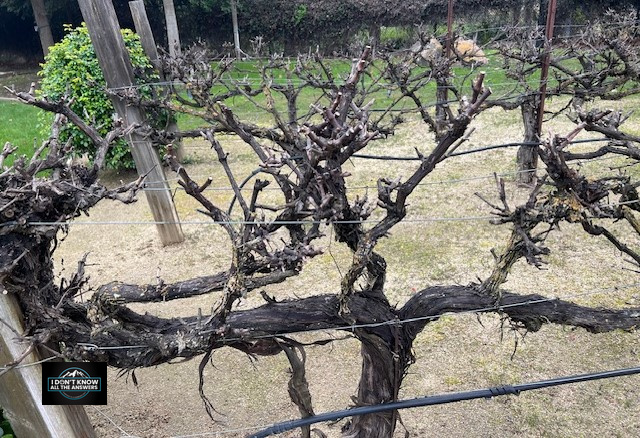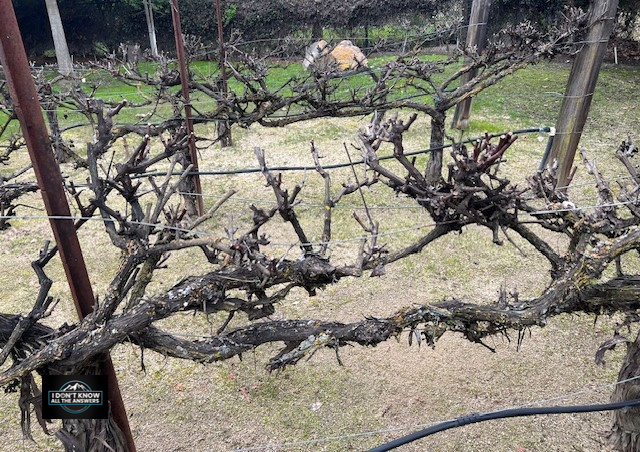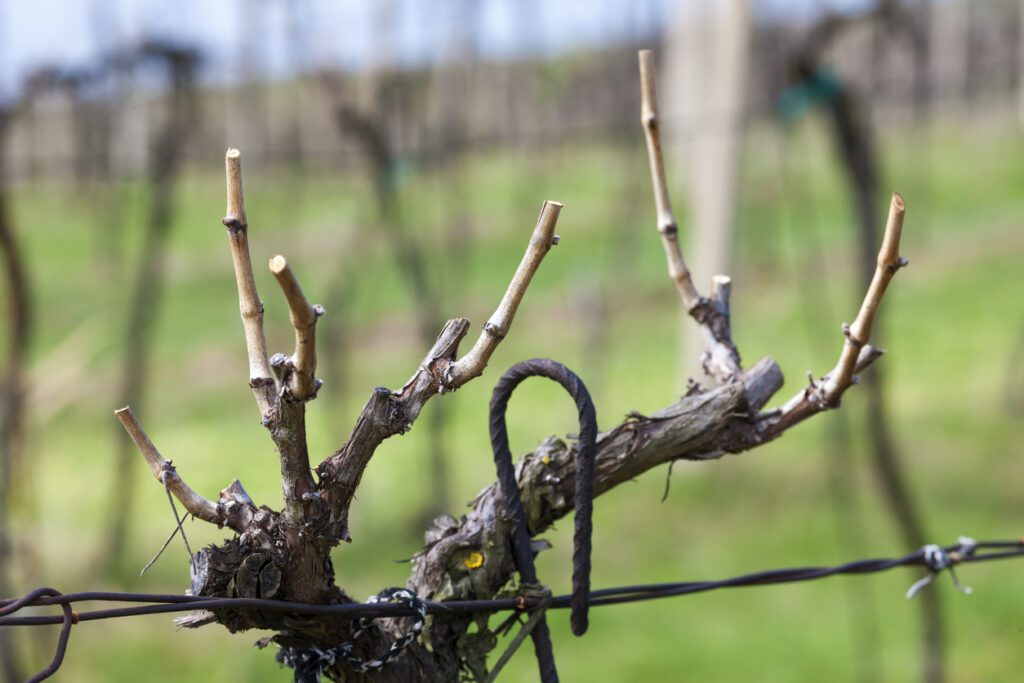Our “new” older house has grapevines in the front and back yards. I have shared that before, but this morning, I learned about the correct method of pruning grapevines and wanted to share that with you. The previous owners of this property had a gardener caring for everything, and Jim and I foolishly thought we could handle it and would not need a gardener, but we quickly realized we needed help. We retained the same gardener, and it’s almost a dream come true to have someone who knows what they’re doing assisting in the care of this property.
There’s something poetic about the vineyard in its dormant state—silent rows of dormant grapevines, patiently waiting for their annual trim, preparing them for a season of bountiful growth. The gardener completed pruning the grapevines. I learned pruning is not merely a task but an annual ritual—a time to connect with each vine’s past and future. Through his shears, he shaped the course of the next harvest.
I’ve learned so much, and I want to share two main techniques of pruning grapevines: Spur and Cane. Choosing between them is as much an art as a science.
Spur Pruning vs. Cane Pruning – Knowing the Difference
Imagine each vine telling us a story of past seasons, each knot and stalk a chapter in its history. Our job is to listen and make editorial cuts to help craft a fruitful tale for the coming year.
Spur Pruning – The Keeper of Continuity
Spur pruning is about retaining a part of the old to nourish the new. Imagine it like editing a long-running, beloved book series—you want to keep the familiar backbone, the characters that your readers (or, in this case, the wine) love. Still, you’re willing to introduce new twists and turns.
Spur pruning deals with mature, vigorous vines that have a stable structure of cordons—those thick, woody branches that seem to stretch out with experienced arms. The method involves cutting back the previous year’s growth to spurs, each holding just a few buds. These spurs, anchored on sturdy limbs, promise new shoots that will bear fruit clusters in the spring and summer.
The Steps to Spur:
- Select healthy, well-placed shoots from last year to become your fruiting spurs.
- Cut each selected shoot back to two or three buds.
- Ensure the spurs are evenly spaced along the cordon, about 4-6 inches apart.
- Thin out any excess spurs to prevent overcrowding and promote good air circulation.



The three pictures above are photos of some of our grapevines. The thickness of the central cane of each plant indicates its age. I believe these plants are 20 years old. You can also see that our gardener used the Spur pruning method to prune these grape vines.

Cane Pruning – Crafting the New Narrative
Then there’s cane pruning, the choice for less vigorous vines or those yearning for a fresh start. Think of it as the beginning of a new epic series, a chance to introduce fresh characters and plotlines.
This method requires a bold approach. You cut back last year’s canes—the long, trailing shoots—maintaining only a few old buds on a much longer cane section. The retained canes are then trained to form the structure of the vine for the year.
The Steps to Cane:
- Identify one or two healthy, strong, and well-positioned canes from the previous year’s growth.
- Prune the selected canes to about 8-15 buds per cane, depending on the vine vigor.
- Remove additional canes at the base, keeping the chosen ones for the vine’s architecture.
- Secure the canes to the trellis; they will become this year’s fruit-bearers.
When to Embark on This Pruning Pilgrimage?
Timing is everything when it comes to pruning. I’ve learned that the best time to prune is before the world wakes up from winter’s sleepy spell—late winter or early spring, right before the buds swell. Pruning too early can leave vines vulnerable to winter injury, and too late can cause them to bleed sap excessively, weakening them.
During this period, the vines are still in their slumber, storing energy for the burst of life that’s soon to come. It’s a window of opportunity where each cut you make is a clear intention set for the year’s growth, crafted without the distraction of foliage and the bustle of a fully awakened vineyard.
Whether following the tradition of spur pruning or the renewal of cane pruning, the narrative helps shape each snip, and trimming is filled with hope for a new chapter of nature’s finest grape harvest.
As you contemplate pruning your grapevines, remember it’s a dialogue. Listen to the whispers of the vines—their vigor, structure, and history—and they’ll guide you. Whether you maintain the legacy of what was or chart a course for something new, your narrative will be woven into each cluster of grapes they yield.
Reference:
Grapevine Cane and Spur Pruning Fundamentals
Thank you for reading this blog post. If you have any questions or comments, please leave them in the Comments section below.
Copyright © 2019. I Don’t Know All The Answers, Nikki Mastro.
All of my photographs and documents are Copyrighted.
Two images for this blog post are from the iStock.com library.
No part of this website, including text, photographs, and documents, may be reproduced, stored in a retrieval system, or transmitted in any form or by any means without written permission from the copyright holder. All unauthorized use is strictly prohibited. If you choose to copy or share any information from my site, you must provide a link to the source. I appreciate your cooperation.
For further information concerning “I Don’t Know All The Answers.”
– Blog: https://www.idontknowalltheanswers.com
– Facebook: https://www.facebook.com/Nikki.L.Mastro
– Instagram: https://www.instagram.com/i_dont_know_all_the_answers/
– Linkedin: https://www.linkedin.com/in/nikki-mastro-05455a3a/
– Youtube Channel: https://www.youtube.com/@idontknowalltheanswers1954

